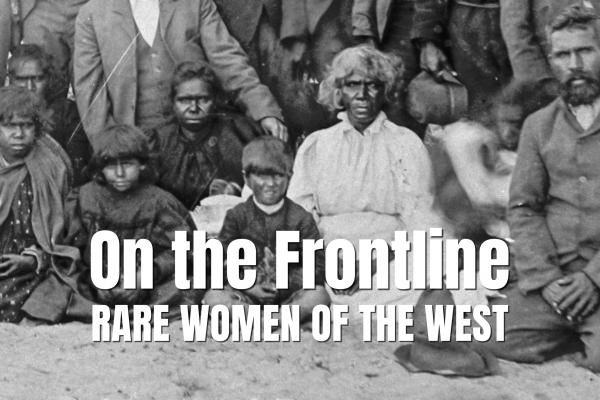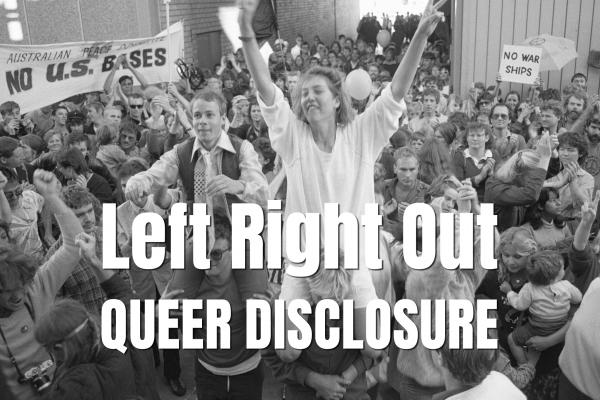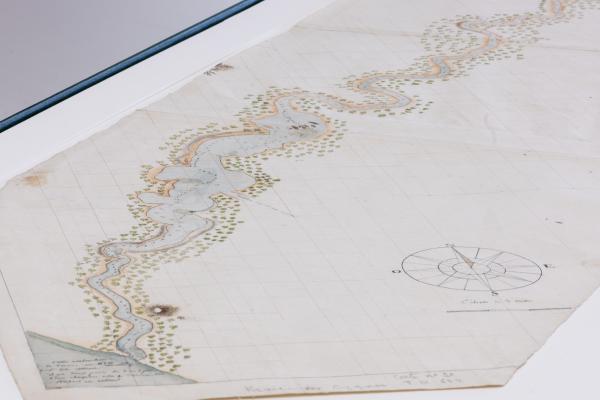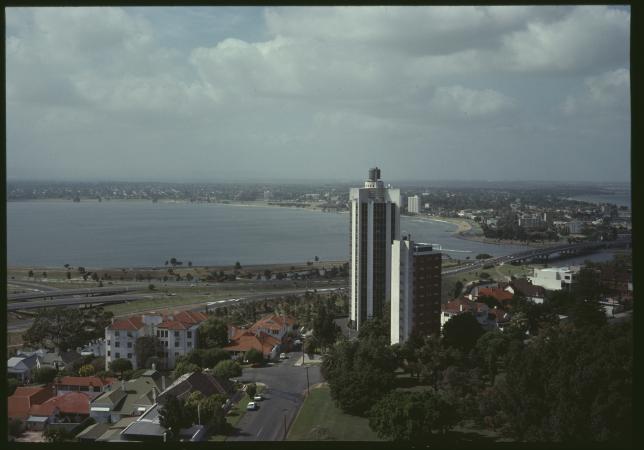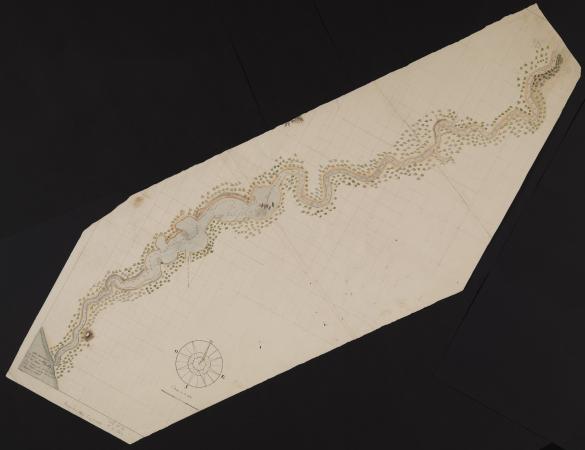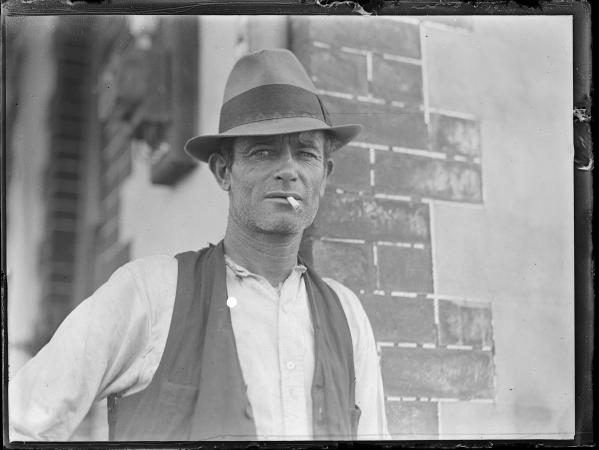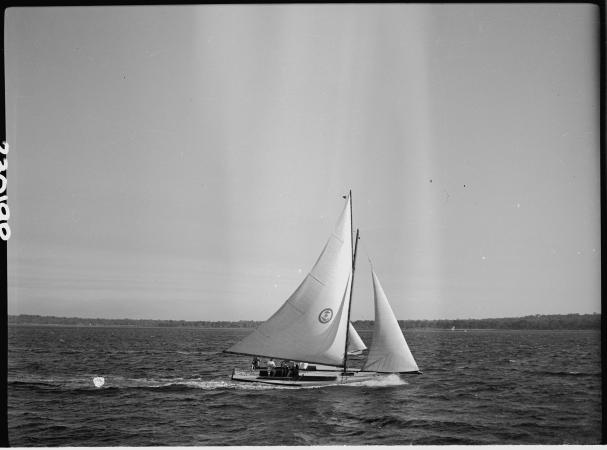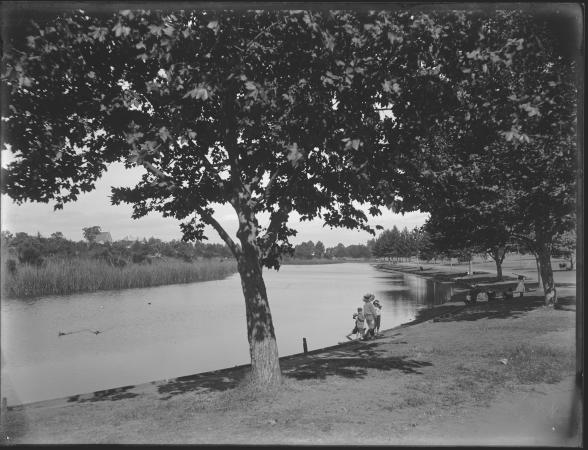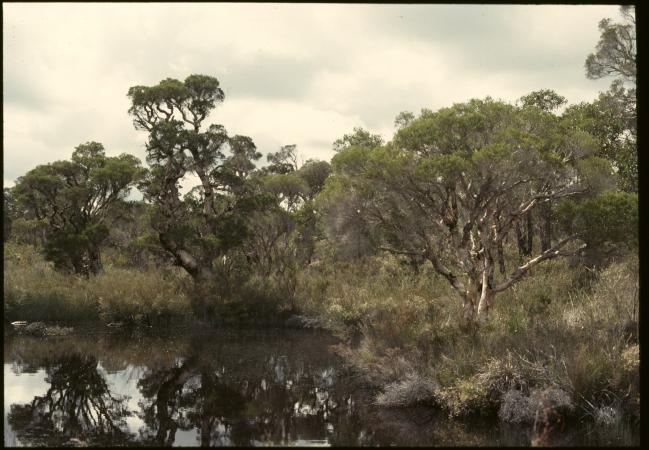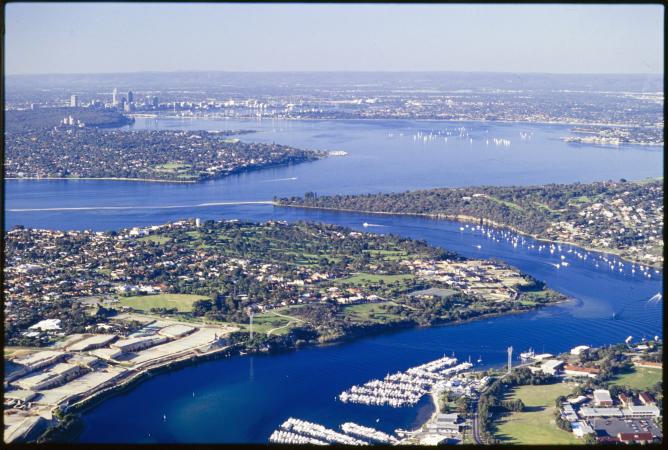Welcome to Rare Stories from the West – a State Library of Western Australia podcast. Through these podcasts we hope to unearth tales of Western Australia’s past and present. Walking on Water: Spirit of the Swan Coastal Plain is the first of three podcasts produced by Gina Pickering.
The Walking on Water podcast explores the significance of the Derbarl Yerrigan (Swan River) in the creation of the city of Perth. The podcast features Aboriginal elders Noel Nannup and Marie Taylor explaining the Aboriginal history of the river through the Waugal creation story on Whadjuck Noongar Boodjar (now metropolitan Perth) and a cultural evocation of the river through the words of poets Dr Nandi Chinna, Jennifer Kornberger and Daniel Hansen.
The environmental context of the river is explored and then the first historical and colonial perceptions of the Swan River by Freycinet and Stirling in the early nineteenth century are discussed. This content roots Derbarl Yerrigan at the heart of any discussion of Perth from its Aboriginal origins to its place at the heart of our twentieth-century multicultural and diverse city, showing why the river is such an important influence for the State Library in its role of telling the story of Western Australia.
Podcasts created by Gina Pickering – Latitude Creative Services and commissioned by the State Library of Western Australia.
Transcript
Gina Pickering: Hi... This is Gina Pickering. I’ve been telling stories about Western Australia since the 1980s.
Over the last 20 years, these yarns have focused on the exceptional cultural aspects of the South West / Noongar Country. In this podcast series, I’ll explore three surprising stories through the voices of Aboriginal Elders, artists, poets, curators and historians and how the State Library of Western Australia is responding to the cultural demands of change in our time.
Home to the oldest continuing culture in the world and located in one of only 34 international biodiversity hotspots 1 , the Derbarl Yerrigan Swan River determined the location of the Western Australian capital, Perth.
Celebrated as Western Australia’s first heritage icon in 2004, the Swan River is both loved and betrayed.
In 2014, the Western Australian Auditor General found, ‘despite two decades of monitoring, planning and intervention, the health of the Swan Canning River system is not adequately protected’ 2 .
The State Library of Western Australia actively conserves the Swan River in its own way through its collection, including precious maps, thousands of images and a commitment to the biggest story in town.
1 International biodiversity hotspots have more than 1500 endemic species of plant and have lost more than 70 per cent of their original habitat: https://www.australiangeographic.com.au/news/2014/02/western-australia-biodiversity-hotspot/
2 https://audit.wa.gov.au/reports-and-publications/reports/heritage-future-health-swan-canning-river-system/find/
Noel Nannup: Most of our stories begin in the nyitting. In fact, all of them do.
And in the beginning, in that cold netting time we've got to ask ourselves what happens with water?
Please remember when it's cold that water freezes. / Noel Nannup:, and when it's frozen, and it's maybe half a kilometer thick sometimes/
some of it will move in a serpentile action. That's what we call Wagyl. And Wagyl simply means that it's a serpent. So when you hear people saying the Wagyl or the Wagyl, maybe they're not wrong, but the correct way to say it is Wau-gyl, and you'll get it that way after singing it many times because there's songs for the river.
Nandi Chinna: Before the river had a name, before there was a person to name it, it swallowed itself whole. Pebble teeth and scouring palette, eating the miles that were not yet miles. Excreting alluvium, building a country onto the end of its tongue.
Daniel Hansen: Koolark Home
From the woodlands to the Sclerophyll,
Of the Eucalypt Forests I know,
Within the air I can certainly feel,
A benevolence which resembles that of Home.
‘Nganyang Kwoorl Daniel Murray Hansen,
Ngany Yoorl Koorl Ballardong Boodjar
Koolarngwetta Wadjuk Boodjar.’
‘We know our place,
We know our Land.’
The King’s Land.
The final resting place of the Waargul spirit,
Where the royalty of the Nyoongar people would hold their Corroborees
The most sacred of land.
Everywhere we declared,
‘Nyanlang Koolark.’
‘Our Home.’
Kate Gregory: So the State Library is really seeking to capture contemporary stories about the Swan River. We're still really interested in the ongoing significance and value. It's obviously, the river is such an important focus point for people who live in Perth, at least. And you know, there's a lot of social activity that occurs around the banks of the river. There's a lot life-changing moments that occur around the banks of the river.
Sue Broomhall: I think Derbarl Yerrigan, or the Swan River, has always been a fundamental emotional resource for the people living around it. And, perhaps we haven't always put that in the foreground. I see it as a very strong emotional dynamic in how we live our lives in this region, for both Aboriginal people, and non-Aboriginal people. And, that we often underestimate just what kind of emotional value it has as a resource to refresh and recharge people. But, I want to say too, that these emotions are very complex, and not always positive.
Sunday Times 19th May 1935: The City Swamps must go.
Hyde Park North Perth was once a bull rush swamp with the native name of Boojamoorling. The central railway station stands where our early settlers only new a lake. Perth oval, Loton Park was swamp country until it was drain 60 odd years ago.
Daniel Martin: Perth was and is a very watery city. It was a whole tapestry of streams and wetlands and waterways that covered the whole coastal plain. Rivers flowing down from the hills. And really interestingly, groundwater, that goes many kilometers below the city (20)
Noel Nannup: And as it comes up, it meets water that's going down from rain cycles and river floods and recharging aquifers that has once been in those deep aquifers and then produces itself in the ocean.
[Spacey sound]
Sarah to Daniel (Town of Vincent): So how is the water level going with the rain we’ve had? The levels are pretty good this year...
Sarah: I think what makes Hyde Park such a special place is that it's been around for so long and everybody seems to have I guess a connection and a memory of the place that they like. (13)
The community uses the park in lots of ways. Lots of passive recreation, picnics, barbecues, social gatherings. I don't think that Hyde Park would have that same significance to people without being able to see the water and the wildlife and the birds and tortoises. (23)
Nandi Chinna: The cartographer is not a boatman dipping his paddle amongst spinning ducks while companionable swans gaggle in the center of his calculations. Beyond his sight, a Swamp Harrier quarters the fringes, scoping the undulations of sedge and reeds.
A line drawn on water cannot be transcribed into chains, perches, miles. Its equations are dismantled by the punting skull of webbed feet.
Daniel Martin: The best way to think of an aquifer, I think, is a mountain of water beneath the city. And these feed all the wetlands. So where the aquifers cross the terrain we get wetlands and we get water. And it's an interesting thing about how these aquifers breathe, because in summer they're low and in winter they're high, and after rainfall they're higher. So there's this swelling sort of landscape that creates the waterways and streams and networks of water throughout Perth. It's quite unique to Perth. (25)
Marie Taylor: The significance of the river here in Noongar Country, is that it was part of the creation story of the Wagyl, the Rainbow Serpent. When he left borage and rock and he came down through York, Northern and back down through Midland, wherever he turned, he created the hole for the river. And then the water came and filled the river up.
The sacredness of the river, is very important to Noongar people, because the Wagyl still sleeps and moves about in the river today.
Noel Nannup: And we're the beneficiaries, not just physically but aesthetically as we watch the product of that rain and that water and how it contributes to our life.
[Sounds of rain]
Nandi Chinna: It unsettles me as I stare into its darkness, but I try not to turn away. I keep looking as long as it flows, parting from itself and meeting itself again in a quiet cove where it will rake the beach, shells lifting and settling like breath. And if I am lucky enough to see black swans moving in pairs, returning home, I wonder if a river could break. I wonder if it is a snake, or a turtle, or if is it a god.
[Sounds of river edge]
Marie Taylor: The big part, the Derbarl Yerrigan of the river, is where the Rainbow Serpents, both played, hunted, and gathered, and then it ended up in becoming a fight. And the male Rainbow Serpent, he went out and he made his home at Gallup Lake Munga. And the female Rainbow Serpent, she went down, she left the Derbarl Yerrigan site, and she went down and created the Canning River site, or Djarlgarro.
Noel Nannup: Yep. So we just need to step back a little and understand that as people move across a landscape in the ancient world, there was major tributaries and smaller ones running in. Let's use the Swan river, for example. If you were to go to the source of that river and do justice by accessing every catchment in it, you would access no less than 27 to 30 catchments that all run into tributaries that run into seven major catchments that then run into either the Avon, the Chittering, the Dale, and the Mackie. And then suddenly you've got this massive catchment that's bringing water into bigger tributaries that then run into the major one.
Sue Broomhall: The river has been seen, since settler times, as a method of transportation, it's very critical in the economic infrastructure of the city, it's also been seen as a playground. But, there are also very dark emotions. It's a place of loss, it's been a place of danger and restriction, perhaps particularly for Aboriginal peoples. But, it also has a dark history of suicides that has not really seen the light of day, but is also part of the emotional complex of the river.
Kate Gregory: So one of the really significant sites in Perth is, of course, the Swan River and this swan river story is really important for our collection. It's a thread throughout our collection. The Swan River, of course, the Swan River colony was settled in 1829. So we have documents in our collection that stretch back to that episode in history, episode of colonization. So we've got early documents from the Swan River colony, including diaries and letters, and we've even got materials that reflect the pre colonization history.
[discussing original map]
The color of it is wonderful, isn't it? We are very lucky to have it. And the first voyage Freycinet was on Baudin's voyage. And this map comes from that voyage and this is all part of the French maritime exploration of the west Australian coast.
Sue Broomhall: So, this is Louis de Freycinet, the cartographer surveyor, who's sailing in the Naturalist in 1801. And, he describes the river, "The channel is obstructed by a bar of rocks, which it is very difficult to pass over, and indeed impracticable if the wind blows from the sea". So, all of the adjectives in there about the difficulty, the impenetrability of the river, and, to a greater extent, the landscape that he's seeing here, and how he can understand it.
I think what's striking, is when you look at the difference between that description by the French in 1801, and the description by James Stirling who's coming at 1827. And, he describes, "The magnificent basin, surrounded by a succession of natural cliffs and wharves, about a mile inside the head it would be the finest harbor in the world, if it had an entrance".
I think what's really important to understand is that when European explorers were looking at the landscape that they found when they arrived in this region of the world, they were looking for places that looked like home.
Jennifer Kornberger:
This river once had a mouth
That opened and closed.
A mouth with limestone teeth
And a tongue of sand.
The first rains woke it
From its estuarine sleep.
Loosening its tongue,
So the mixing the darbaling could begin.
Noel Nannup: And when you start talking about water, then water is the biggest story because it's everywhere. It's under the ground, so the term walking on water is applicable. And when you say that in the modern world, most people think of when Jesus walked on the water during that storm. And so people will understand in some format. But that'll connect them back to the very important component, which is the spirit of a place and the spirit of everything. Because we believe everything's connected. Everything. And that means physically and spiritually.
[Sounds of boat wash and sailing...]
Marie Taylor: In 2020, I was appointed Elder in Residence at the South of Perth Yacht Club. And for me, I was very honored, because I knew that it was a position that could make a lot of difference, not only in the lives and the workplace of the yacht club, but also in our lives, because we had never been involved in a yacht club before, and we would always drive past it and think, I wonder what goes on there.
it has broken a lot of barriers that normally would be within an organization, that doesn't have a lot of Aboriginal people involved in.
When we look at our history, our history links us to the first sail boats that came here to Western Australia. The Noongar people used to think that they were ghosts, and they called the boats Changas.
We've got a history from that time, to now, many of it's been very sad, been spoken about, we've shed tears over, but there came a day when government signed off on reconciliation, and it brought the Aboriginal person and the white person back to each other's side. That links me to where I am at the South of Perth Yacht Club, because here I'm seeing reconciliation happening, and being practiced when Aboriginal people and non-Aboriginal people are standing together with the link being boats.
Because Whadjuk Country is matrilineal country, for me, it tells me that the women have a very close link and responsibility towards the river.
[Lapping of water]
Jennifer Kornberger:
When rainbows become scarce
The river sealed its mouth,
It curled back and listened to the thousand voices informing it.
A river lives between course and discourse.
It has business,
The office of its whole catchment to fulfill
Noel Nannup: So when we talk about Noongar leadership, you'll have many different perspectives. The way I see it is, the non-Aboriginal world has had their turn and they’ve failed every time, In relation to looking after the land and our needs as Aboriginal people. We're a different culture, and therefore, we have a different ways of doing and being and knowing.
If it's Aboriginal-led, then the spirit comes with it and there'll be people that say, well so what? but then there's all of those that understand that if we lose our spirituality, then who are we? What have we got?
Gina Pickering: In 2021, the tide is changing. Native Title is unfurling, Noongar led initiatives including Danjoo Koorliny which literally means walking together are providing community leadership and universities are focused on reconnecting the rivers. At Curtin University a creek and wetland are a focus of a new research hub.
[Sounds of swans and birdlife]
Noel Nannup: The sad reality for Blackadder Creek is when they first settled that area and built the first dwelling there on the bend, that was where they put a rubbish tip, and they were throwing lots of toxic material into that rubbish tip for years. And now you have this toxic bloom under the ground trying to make its way towards the west, and it's sitting there and it's really putrid. And that's... On that bend is where our Wargyl appears and has done for a very long time. And the last time it was seen was on that bend, and that was in living memory.
We would prefer to see it go to park land and be encompassed within this project that Curtin's doing. And we'll give it our best shot to try and to save it and see how we go. And then it can become part of the biggest story that we can interpret for people.
Nandi Chinna: We are aging now and dressed in sensible shoes and coats. We are longing to know what the river might say or what we might hear if we make this small bow, kneeling into the lee of the sand bank, if we scatter these Aeolian particles into the moving tide and meet them in the returning wind. Where the fingers have gouged, a shell of memory remains in the sand, just moments before the next wave breaks into that territory, where the country has met the person for the first time.
You may be interested in...
